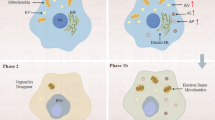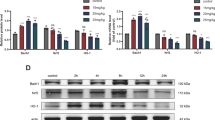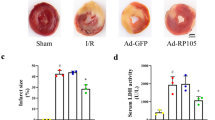Abstract
Objectives: Our previous study has shown that slow or “controlled” reperfusion for the ischemic heart reduces cardiomyocyte injury and myocardial infarction, while the mechanisms involved are largely unclear. In this study, we tested the hypothesis that enhancement of survival and prevention of apoptosis in hypoxic/reoxygenated cardiomyocytes by hypoxic postconditioning (HPC) are associated with the reduction in peroxynitrite (ONOO−) formation induced by hypoxia/reoxygenation (H/R). Methods: Isolated adult rat cardiomyocytes were exposed to 2 h of hypoxia followed by 3 h of reoxygenation. After 2 h of hypoxia the cardiomyocytes were either abruptly reperfused with pre-oxygenized culture medium or postconditioned by two cycles of 5 min of brief reoxygenation and 5 min of re-hypoxia followed by 160 min of abrupt reoxygenation. Results: H/R resulted in severe injury in cardiomyocytes as evidenced by decreased cell viability, increased LDH leakage in the culture medium, increased apoptotic index (P values all less than 0.01 vs. normoxia control group) and DNA ladder formation, which could be significantly attenuated by HPC treatment applied before the abrupt reoxygenation (P < 0.05 vs. H/R group). In addition, H/R induced a significant increase in ONOO− formation as determined by nitrotyrosine content in cardiomyocytes (P < 0.01 vs. normoxia control). Treatment with the potent ONOO− scavenger uric acid (UA) at reoxygenation significantly decreased ONOO− production and protected myocytes against H/R injury, whereas the same treatment with UA could not further enhance myocyte survival in HPC group (P > 0.05 vs. HPC alone). Statistical analysis showed that cell viability closely correlated inversely with myocyte ONOO− formation (P < 0.01). Conclusion: These data demonstrate that hypoxic postconditioning protects myocytes against apoptosis following reoxygenation and enhances myocytes survival, which is partly attributable to the reduced ONOO− formation following reoxygenation.
Similar content being viewed by others
References
Hearse DJ, Bolli R (1992) Reperfusion induced injury: manifestations, mechanisms, and clinical relevance. Cardiovasc Res 26:101–108
Haunstetter A, Izumo S (1998) Apoptosis: basic mechanisms and implications for cardiovascular disease. Circ Res 82:1111–1129
Murry CE, Jennings RB, Reimer KA (1986) Preconditioning with ischemia: a delay of lethal cell injury in ischemic myocardium. Circulation 74:1124–1136
Eisen A, Fisman EZ, Rubenfire M et al (2004) Ischemic preconditioning: nearly two decades of research. A comprehensive review. Atherosclerosis 172:201–210
Braunwald E, Kloner RA (1985) Myocardial reperfusion: a double-edged sword?. J Clin Invest 76:1713–1719
Vinten-Johansen J, Zhao ZQ, Zatta AJ, Kin H, Halkos ME, Kerendi F (2005) Postconditioning A new link in nature's armor against myocardial ischemia-reperfusion injury. Basic Res Cardiol 100:295–310
Acar C, Partington MT, Buckberg GD (1990) Studies of controlled reperfusion after ischemia. XVIII. Reperfusion conditions: attenuation of the regional ischemic effect by temporary total vented bypass before controlled reperfusion. J Thorac Cardiovasc Surg 100:737–744
Julia PL, Buckberg GD, Acar C, Partington MT, Sherman MP (1991) Studies of controlled reperfusion after ischemia. XXI. Reperfusate composition: superiority of blood cardioplegia over crystalloid cardioplegia in limiting reperfusion damage-importance of endogenous oxygen free radical scavengers in red blood cells. J Thorac Cardiovasc Surg 101:303–313
Li Y, Tao L, Zang YM, Gao F (2002) Effects of ischemic postconditioning on myocardial apoptosis and infarction in rabbits with acute myocardial ischemia and reperfusion. J Fourth Mil Med Univ 23:1690–1693
Gao F, Yan WL, Fan Q, Lopez BL, Christopher TA, Ma XL (2001) Hypoxic “postconditioning” protects rat cardiac myocytes against reoxygenation injury. FASEB J 15:A465
Zhao ZQ, Corvera JS, Halkos ME et al (2003) Inhibition of myocardial injury by ischemic postconditioning during reperfusion: comparison with ischemic preconditioning. Am J Physiol Heart Circ Physiol 285:H579–H588
Tsang A, Hausenloy DJ, Mocanu MM, Yellon DM (2004) Postconditioning: a form of “modified reperfusion” protects the myocardium by activating the phosphatidylinositol 3-kinase-Akt pathway. Circ Res 95:230–232
Sun HY, Wang NP, Kerendi F et al (2005) Hypoxic postconditioning reduces cardiomyocyte loss by inhibiting ROS generation and intracellular Ca2+ overload. Am J Physiol Heart Circ Physiol 288:H1900–H1908
Gao F, Gao E, Yue TL, Ohlstein EH et al (2002) Nitric oxide mediates the antiapoptotic effect of insulin in myocardial ischemia-reperfusion: the roles of PI3-kinase, Akt, and endothelial nitric oxide synthase phosphorylation. Circulation 105:1497–1502
Razavi HM, Hamilton JA, Feng Q (2005) Modulation of apoptosis by nitric oxide: implications in myocardial ischemia and heart failure. Pharmacol Ther 106:147–162
Zweier JL, Wang P, Kuppusamy P (1995) Direct measurement of nitric oxide generation in the ischemic heart using electron paramagnetic resonance spectroscopy. J Biol Chem 270:304–307
Schulz R, Wambolt R (1995) Inhibition of nitric oxide synthesis protects the isolated working rabbit heart from ischaemia-reperfusion injury. Cardiovasc Res 30:432–439
Marfella R, Di Filippo C, Esposito K et al (2004) Absence of Inducible Nitric Oxide Synthase Reduces Myocardial Damage During Ischemia Reperfusion in Streptozotocin-Induced Hyperglycemic Mice. Diabetes 53:454–462
Beckman JS, Beckman TW, Chen J, Marshall PA, Freeman BA (1990) Apparent hydroxyl radical production by peroxynitrite: implications for endothelial injury from nitric oxide and superoxide. Proc Natl Acad Sci USA 87:1620–1624
Arstall MA, Sawyer DB, Fukazawa R, Kelly RA (1999) Cytokine-mediated apoptosis in cardiac myocytes: the role of inducible nitric oxide synthase induction and peroxynitrite generation. Circ Res 85:829–840
Ma XL, Gao F, Lopez BL, Christopher TA, Vinten-Johansen J (2000) Peroxynitrite, a two-edged sword in post-ischemic myocardial injury—dichotomy of action in crystalloid- versus blood-perfused hearts. J Pharmacol Exp Ther 292:912–920
Zhang B, Zhang HF, Fan Q, Ma XL, Gao F (2003) Insulin improves cardiac myocytes contractile function recovery in simulated ischemia-reperfusion: key role of Akt. Chin Sci Bull 48:1364–1369
Lepore DA, Stewart AG, Tomasi A, Anderson RL, Hurley JV, Morrison WA (1999) The survival of skeletal muscle myoblasts in vitro Is sensitive to a donor of nitric oxide and superoxide, SIN-1, but not to nitric oxide or peroxynitrite alone. Nitric Oxide: Biol Chem 3:273–280
Brar BK, Stephanou A, Liao Z et al (2001) Cardiotrophin-1 can protect cardiac myocytes from injury when added both prior to simulated ischemia and at reoxygenation. Cardiovasc Res 51:265–274
Regan RF, Kumar N, Gao F, Guo Y (2002) Ferritin induction protects cortical astrocytes from heme-mediated oxidative injury. Neuroscience 113:985–994
Nakano M, Knowlton AA, Dibbs Z, Mann DL (1998) Tumor necrosis factor-alpha confers resistance to hypoxic injury in the adult mammalian cardiac myocyte. Circulation 97:1392–1400
Zhang HF, Fan Q, Qian XX, Lopez BL et al (2004) Role of insulin in the anti-apoptotic effect of glucose-insulin-potassium in rabbits with acute myocardial ischemia and reperfusion. Apoptosis 9:777–783
Iwai-Kanai E, Hasegawa K, Araki M, Kakita T, Morimoto T, Sasayama S (1999) alpha- and beta-adrenergic pathways differentially regulate cell type-specific apoptosis in rat cardiac myocytes. Circulation 100:305–311
Gao F, Yao CL, Gao E et al (2002) Enhancement of glutathione cardioprotection by ascorbic acid in myocardial reperfusion injury. J Pharmacol Exp Ther 301:543–550
Trackey JL, Uliasz TF, Hewett SJ (2001) SIN-1-induced cytotoxicity in mixed cortical cell culture: peroxynitrite-dependent and -independent induction of excitotoxic cell death. J Neurochem 79:445–455
Yasmin W, Strynadka KD, Schulz R (1997) Generation of peroxynitrite contributes to ischemia-reperfusion injury in isolated rat hearts. Cardiovasc Res 33:422–432
Ferdinandy P, Danial H, Ambrus I, Rothery RA, Schulz R (2000) Peroxynitrite is a major contributor to cytokine-induced myocardial contractile failure. Circ Res 87:241–247
Yang XM, Philipp S, Downey JM, Cohen MV (2005) Postconditioning's protection is not dependent on circulating blood factors or cells but involves adenosine receptors and requires PI3-kinase and guanylyl cyclase activation. Basic Res Cardiol 100:57–63
Kin H, Zhao ZQ, Sun HY et al (2004) Postconditioning attenuates myocardial ischemia-reperfusion injury by inhibiting events in the early minutes of reperfusion. Cardiovasc Res 62:74–85
Author information
Authors and Affiliations
Corresponding author
Additional information
H.-C. Wang and H.-F. Zhang contributed equally to this study.
Rights and permissions
About this article
Cite this article
Wang, HC., Zhang, HF., Guo, WY. et al. Hypoxic postconditioning enhances the survival and inhibits apoptosis of cardiomyocytes following reoxygenation: role of peroxynitrite formation. Apoptosis 11, 1453–1460 (2006). https://doi.org/10.1007/s10495-006-7786-z
Published:
Issue Date:
DOI: https://doi.org/10.1007/s10495-006-7786-z




